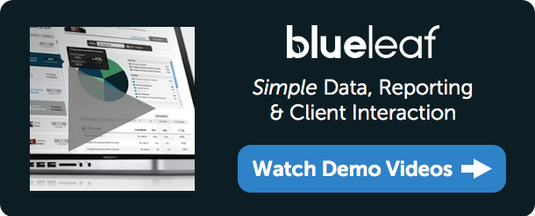Last Updated on July 20, 2020 by Phil Rogers
I work hard to improve my growing RIA business. Attracting and retaining new clients is a vital part of this.
I test everything I can making decisions based on facts, not just gut feeling.

So, while I’m already a Blueleaf customer, I wanted to prove if the investment in Blueleaf was worth it.
In other words, ‘Was Blueleaf helping my business?’
Life without Blueleaf proved to be very tough indeed.
For my test, I had three new clients (Group A) use Blueleaf, and three (Group B) who did not.
-
Group A
Group A were invited to Blueleaf after we had gone through their financial plan.
I showed them how we would use Blueleaf to track account movements now that we were consolidating accounts, but they could also see how their accounts were performing with quick snapshots throughout the month.
I explained how the weekly update email would help de-sensitize them to short-term market movements and the emails would be a chance for us to discuss what was going on their various accounts.
-
Group B
For Group B, I told them we would start consolidating their accounts and asked them to let me know when their new accounts had been funded.
At that point, I would provide them trade recommendations and we would check in a week later to ensure the trades had gone through.
I hated the Group B process even before it started.
Once my first Group A client had signed up for Blueleaf, I knew what a time savings this was going to be for me.
Once they got their first weekly update email, they sent me a message saying how easy it was to understand and that they knew that weekly moves were inconsequential.
One of these group members also gave me forewarning of a large withdrawal in their accounts for a project they were completing, so I shouldn’t be alarmed when it happened.
I was bonding more quickly with Group A than the other group.
I felt my investment-focused conversations with this group were more dynamic and natural.
The process of consolidating accounts with Group B was painful.
I don’t manage assets, so it was a case of checking in with my clients, having them log into their accounts to see if changes had been made.
Not only was this a bad process on my part, but I cringed every time I did it because I knew the solution to this problem was being used with Group A.
Things got worse.
After having gone through a 12-month process with Group B, I started asking them about completing an annual review.
Even after understanding that they had gone through the “heavy lifting” of their plan and the account juggling was over, they weren’t as engaged as I thought they would be.
We started the review process by me asking them to provide updated balances for their accounts.
Having seen the tedious process Group B went through the first time, I knew this was something they were not looking forward to.
I started the review process with the clients not using Blueleaf. Before I even started, two of Group B terminated me as their advisor.
In contrast, all of Group A were so engaged in their finances, they welcomed the chance to sit down, discuss their life, knowing that we had both been monitoring their accounts throughout the year.
While I can’t say that not using Blueleaf caused clients to leave my firm, I can say that by using Blueleaf, I have a group of clients who are far more engaged than those who don’t use it.
So what happens now?
All of my clients will be using Blueleaf from here on. It will be a standard tool for all clients.
But what about you?
Not a user of Blueleaf? (“Yet”, I might add).
Why not do something similar to what I did – take it for a test run and do a test with your clients.
Look at the time savings it offers.
See how your client’s face lights up when they realize they can see everything in one place.
Make your associate’s day by telling them that the data entry phase of their job just got cut in half.
For your free trial of Blueleaf, sign up here.
